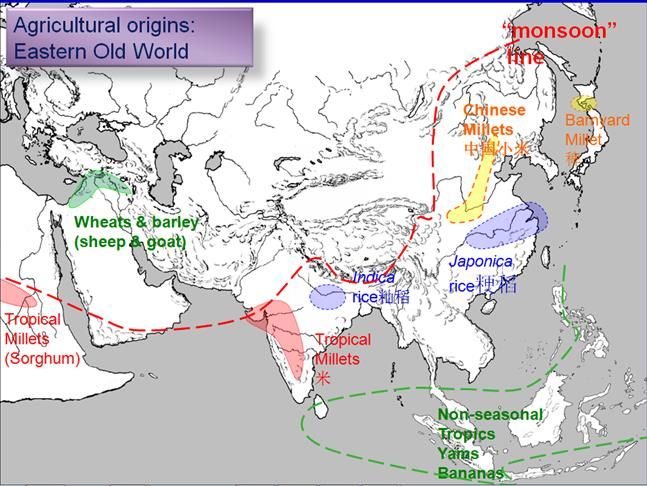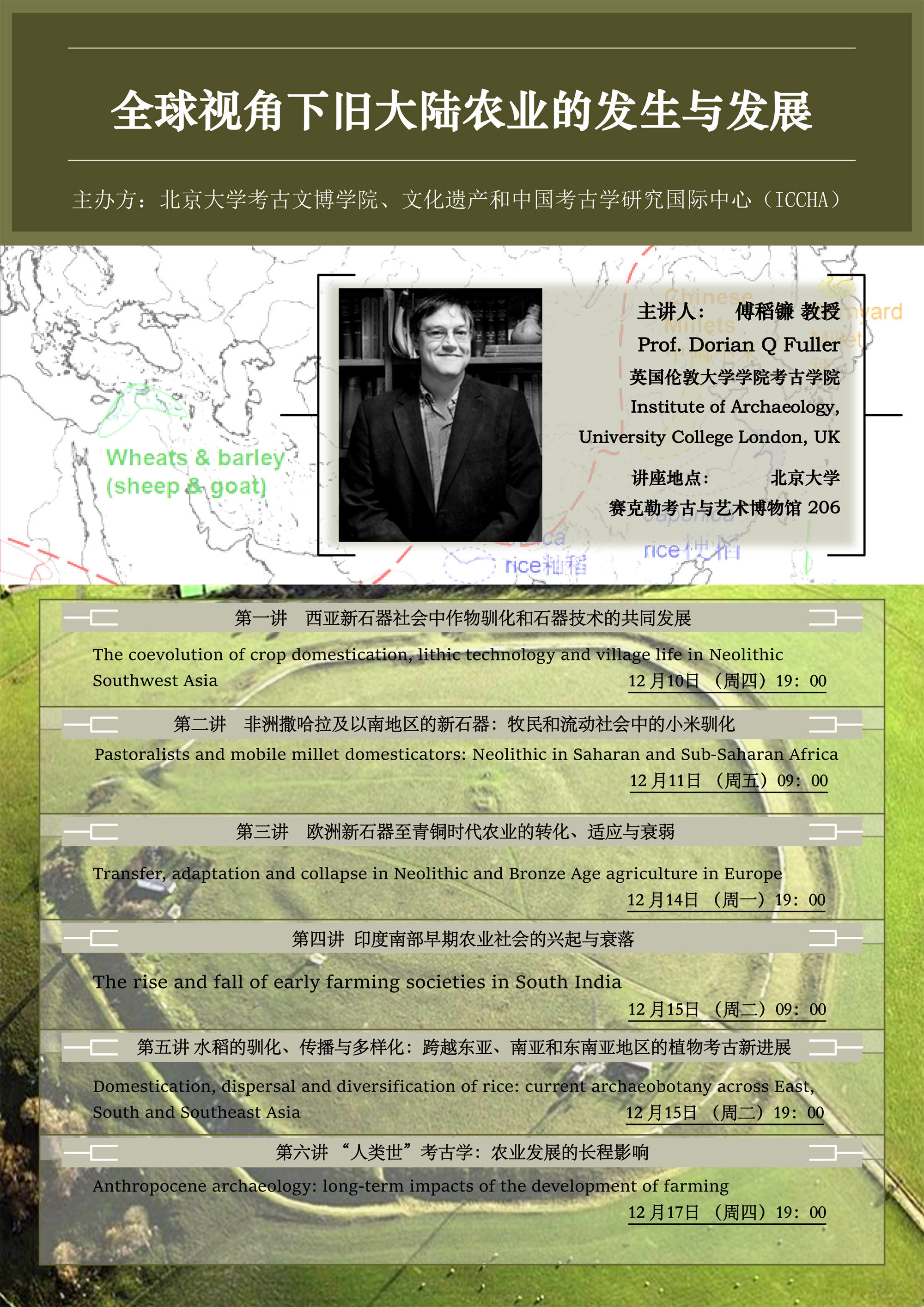主讲人:Prof. Dorian Q Fuller 傅稻镰教授
Institute of Archaeology, University College London, UK
英国伦敦大学学院考古学院
讲座时间:2015年12月10日~12月17日(共六次)
讲座地点:北京大学考古文博学院博物馆206(暂定)
讲座为英语,现场有翻译。

农业起源是人类历史进程中历久弥新的一个研究主题,本系列讲座名为“全球视角下农业的发生与发展”,实际上也是一个学术前沿系列。主讲人基于近年来西亚、印度、中国和非洲地区的田野考古及实验室工作,将对旧大陆不同地区的农业起源与植物考古研究进行逐一考察;并对“人类世”——这一基于人类行为对全球生态气候影响的地质年代新术语——进行考古学角度讨论。

主讲人Dorian Q Fuller傅稻镰是伦敦大学学院(University College London)考古学院教授,文化遗产保护与中国考古学研究国际中心(ICCHA)主任。他的主要研究领域为植物考古学、农业考古和新石器时代考古,田野工作包括印度、中国、东南亚及非洲北部等多个地区与国家。已发表学术论文两百四十余篇。傅稻镰教授正在主持开展ERC(欧洲研究委员会)项目“农业之路的比较研究”;并获得英国NERC(自然环境研究委员会)资助开展另一项关于稻作在中国和东南亚传播的课题。
本系列讲座由北京大学考古文博学院与文化遗产保护与中国考古学研究国际中心(ICCHA)共同组织举办。

This lecture will explore the some of the most recent research on the origins of agriculture and archaeobotany in various parts of the Old World, based on fieldwork in recent years and new or recent laboratory analyses of plant remains from Western Asia, India, China and parts of Africa. We will also consider the recent discussions around the term “Anthropocene” seen by some as a new geological epoch in which human activities have an impact that has modified earth’s ecologies and climate at a global level. Professor Fuller currently runs a major research project funded by the European Research Council on “Comparative Pathways to Agriculture” and another funded by the UK Natural Environment Research Council on the spread of rice and its impact in China and Southeast Asia.

讲座日程:
第一讲 西亚新石器社会中作物驯化和石器技术的共同发展
The coevolution of crop domestication, lithic technology and village life in Neolithic Southwest Asia
12月10日(周四)19:00
第二讲 非洲撒哈拉及以南地区的新石器:牧民和流动社会中的小米驯化
Pastoralists and mobile millet domesticators: Neolithic in Saharan and Sub-Saharan Africa
12月11日(周五)9:00
第四讲 欧洲新石器至青铜时代农业的转化、适应与衰弱
Transfer, Adaptation and Collapse in Neolithic and Bronze Age agriculture in Europe
12月14日(周一)
19:00第三讲 印度南部早期农业社会的兴起与衰落
The rise and fall of early farming societies in South India
12月15日(周二)9:00
第五讲 水稻的驯化、传播与多样化:跨越东亚、南亚和东南亚地区的植物考古新进展
Domestication, dispersal and diversification of rice: current archaeobotany across East, South and Southeast Asia
12月15日(周二)19:00
第六讲 “人类世”考古学:农业发展的长程影响
Anthropocene Archaeology: Long-term impacts of the development of farming
12月17日(周四)19:00
讲座内容与延伸阅读:
1. The coevolution of crop domestication, lithic technology and village life in Neolithic Southwest Asia
This lecture will present the latest research on the transition to farming in Southwest Asia’s fertile crescent, including the evidence for the evolution of domesticated wheat and barley, and how this relates to the evolution of the technology of cereal harvesting (sickle blades) and the economic transition from a collecting economy with some cultivation to a predominantly agricultural economy.
Background reading:
Asouti & Fuller (2013) A Contextual Approach to the Emergence of Agriculture in Southwest Asia: Reconstructing Early Neolithic Plant-Food Production,Current Anthropology 54 (3): 299-345
2. Pastoralists and mobile millet domesticators: Neolithic in Saharan and Sub-Saharan Africa
This lecture will look at current evidence for plant domestication and the transition to agriculture in the Sudan and Mali, based on sorghum and pearl millet. While pastoralism mixed with hunting and gathering become widespread in era of the Green Sahara (6000-3000 BC), drying climatic condition forced population southwards and set off the beginnings of cultivation. New evidence from the use of millet chaff in ceramic pastes preserves clues for the domestication processes in sorghum and pearl millet.
Background reading:
Manning, Katie and Dorian Q Fuller (2014) Early Millet Farmers in the Lower Tilemsi Valley, Northeastern Mali, In: Stevens, Chris J., Sam Nixon, Mary Anne Murray, and Dorian Q Fuller (Eds.) The Archaeology of African Plant Use. Left Coast Press, Walnut Creek, Ca. Pp. 73-82 [Available on academia.edu]
3. Transfer, Adaptation and Collapse in Neolithic and Bronze Age agriculture in Europe
This lecture will review the evidence for the spread of west Asian agriculture into Neolithic Europe starting before 8000 BP and reaching Britain around 6000 BP. Nevertheless new research indicates that throughout most of Europe early agricultural societies suffered population collapse, in Britain between 5300 and 5000 BP. The potential role of warfare, over exploitation of soils and climatic change will be considered. The Bronze Age, the represents a second resurgence of agriculture which in many region appear to represent a new introduction involving new immigrant populations. Recent evidence from aDNA, and hypotheses connecting these new populations to Indo-European speaking peoples from Central Asia will be considered.
Background Reading:
Stevens, C. J., & Fuller, D. Q. (2015). Alternative strategies to agriculture: the evidence for climatic shocks and cereal declines during the British Neolithic and Bronze Age (a reply to Bishop). World Archaeology, 47(5), 856-875.
Rosie R. Bishop (2015) Did Late Neolithic farming fail or flourish? A Scottish perspective on the evidence for Late Neolithic arable cultivation in the British Isles, World Archaeology, 47(5), 834-855.
4. The rise and fall of early farming societies in South India
This lecture will review the current evidence for the emergence of sedentary farming villages in South India (Karnataka state), which were based on a mixture of introduced pastoralism and indigenous domestication of millets and beans. Society was focused on hilltop villages and seasonal cattle fair that left behind large ashmounds. Social changes and climatic drying forced an end this tradition through a combination of site abandonment in direr region and a focus on more hierarchical social system concerned with iron metallurgy and control of water.
Background reading:
Roberts, P., Boivin et al (2015). Local diversity in settlement, demography and subsistence across the southern Indian Neolithic-Iron Age transition: site growth and abandonment at Sanganakallu-Kupgal. Archaeological and Anthropological Sciences, 1-25. DOI: 10.1007/s12520-015-0240-9
5. Domestication, dispersal and diversification of rice: current archaeobotany across East, South and Southeast Asia
This lecture will review the current record for the origins and spread of rice, from Yangtze domestication zones to the dispersals to Yunnan, Thailand and India. We will consider the evidence for whether rice was grown wet or dry. And we will review the current evidence for a distinctive hybridization process in India (the ‘proto-indica’ hypothesis).
Background reading:
FULLER, DQ (2011) Pathways to Asian Civilizations: Tracing the Origins and Spread of Rice and Rice Cultures. Rice 4(3-4): 78-92 DOI 10.1007/s12284-011-9078-7
6. Anthropocene Archaeology: Long-term impacts of the development of farming
Currently there is much debate about whether or a not a new geological era the “Anthropocene should be recognized, and if so, when does it begin. This lecture will introduce the arguments for an early anthropocene, i.e. a prehistoric change in the earth system in which human activities at a global scale begin to influence climate patterns. This includes the role of rice and livestock in creating extra methane, and the spread of farming and deforestation in adding to carbondioxide. We will consider how archaeological evidence can and should be used to contribute to this debate by building empirical evidence for the scale of past landuse.
Background reading:
Ellis, E. C., Kaplan, J. O., Fuller, D. Q., Vavrus, S., Goldewijk, K. K., & Verburg, P. H. (2013). Used planet: A global history. Proceedings of the National Academy of Sciences, 110(20), 7978-7985.